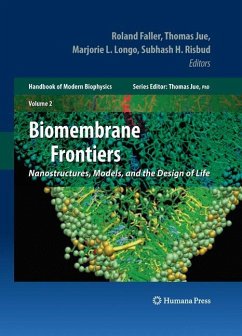This is the second book in the Handbook Of Modern Biophysics series. The Handbook of Modern Biophysics: Biomembrane Frontiers: Nanostructures, Models, and the Design of Life will focus on frontiers in biomembranes, a pertinent topic in modern biophysics. All contributors lead the membrane research field as active, well respected researchers/educators at Carnegie-Mellon University, Finland Institute of Physics, Los Alamos National Laboratory, Sandia National Laboratory, Stanford University, University of Calgary, University of California, University of Pennsylvania, and Vanderbilt University.
HANDBOOK OF MODERN BIOPHYSICS
Series Editor Thomas Jue, PhD
Handbook of Modern Biophysics brings current biophysics topics into focus, so that biology, medical, engineering, mathematics, and physical-science students or researchers can learn fundamental concepts and the application of new techniques in addressing biomedical challenges. Chapters explicate the conceptual framework of the physics formalism and illustrate the biomedical applications. With the addition of problem sets, guides to further study, and references, the interested reader can continue to explore independently the ideas presented.
Volume II: Biomembrane Frontiers: Nanostructures, Models, and the Design of Life
Editors: Roland Faller, PhD, Thomas Jue, PhD, Marjorie L. Longo, PhD, and Subhash H. Risbud, PhD
In Biomembrane Frontiers: Nanostructures, Models, and the Design of Life, prominent researchers have established a foundation for the study of biophysics related to the following topics:
Perspectives: Complexes in Liquids, 1900-2008
Molecular Theory Applied to Lipid Bilayers and Lipid-Protein Interactions
Membrane Elasticity and Mediated Interactions in Continuum Theory: A Differential Geometric Approach
Structure and Dynamics of Lipid Monolayers: Theory and Applications
Multiscale Modeling of Supported Lipid Bilayers
Collective Dynamics in Lipid Membranes:
From Pore Formation to Flip-Flops
Spatiotemporal Organization of Spin-Coated Supported Model Membranes
Nanopore Analysis of Nucleic Acids: Single-Molecule
Studies of Molecular Dynamics, Structure, and Base Sequence
Complex Applications of Simple FRAP on Membranes
Punching Holes in Membranes: HowOligomeric
Pore-Forming Proteins and Lipids Cooperate to Form Aqueous Channels in Membranes
Morphogens, Membranes and Mechanotransduction in Articular Cartilage
Lifecycle of a Lipoprotein from a Biophysical Perspective
Targeting Apolipoproteins in Magnetic Resonance Imaging
About the Editors
The editors are internationally recognized biomembrane experts and have published extensively on the structure, dynamics, and function of model and cellular membranes. Roland Faller is an Associate Professor and the Joe & Essie Smith Endowed Chair in the Department of Chemical Engineering & Materials Science at the University of California Davis. He develops and uses modern molecular simulation techniques for soft condensed matter systems, particularly biomembranes. Thomas Jue is a Professor in the Department of Biochemistry and Molecular Medicine at the University of California Davis. He develops and applies magnetic resonance techniques to study biochemical regulation in vivo. Marjorie L. Longo is a professor in the Department of Chemical Engineering and Materials Science at the University of California Davis. She applies microscopy techniques to study surface and transport properties of lipid bilayers and monolayers. Subhash H. Risbud is the Blacutt-Underwood Distinguished Professor of Materials Science in the Department of Chemical Engineering and Materials Science at the University of California at Davis and a Visiting Professor at Stanford University. His group develops new materials for nano- and biotechnology. The materials include glasses, ceramics, and nanoporous substrates for biological membranes.
HANDBOOK OF MODERN BIOPHYSICS
Series Editor Thomas Jue, PhD
Handbook of Modern Biophysics brings current biophysics topics into focus, so that biology, medical, engineering, mathematics, and physical-science students or researchers can learn fundamental concepts and the application of new techniques in addressing biomedical challenges. Chapters explicate the conceptual framework of the physics formalism and illustrate the biomedical applications. With the addition of problem sets, guides to further study, and references, the interested reader can continue to explore independently the ideas presented.
Volume II: Biomembrane Frontiers: Nanostructures, Models, and the Design of Life
Editors: Roland Faller, PhD, Thomas Jue, PhD, Marjorie L. Longo, PhD, and Subhash H. Risbud, PhD
In Biomembrane Frontiers: Nanostructures, Models, and the Design of Life, prominent researchers have established a foundation for the study of biophysics related to the following topics:
Perspectives: Complexes in Liquids, 1900-2008
Molecular Theory Applied to Lipid Bilayers and Lipid-Protein Interactions
Membrane Elasticity and Mediated Interactions in Continuum Theory: A Differential Geometric Approach
Structure and Dynamics of Lipid Monolayers: Theory and Applications
Multiscale Modeling of Supported Lipid Bilayers
Collective Dynamics in Lipid Membranes:
From Pore Formation to Flip-Flops
Spatiotemporal Organization of Spin-Coated Supported Model Membranes
Nanopore Analysis of Nucleic Acids: Single-Molecule
Studies of Molecular Dynamics, Structure, and Base Sequence
Complex Applications of Simple FRAP on Membranes
Punching Holes in Membranes: HowOligomeric
Pore-Forming Proteins and Lipids Cooperate to Form Aqueous Channels in Membranes
Morphogens, Membranes and Mechanotransduction in Articular Cartilage
Lifecycle of a Lipoprotein from a Biophysical Perspective
Targeting Apolipoproteins in Magnetic Resonance Imaging
About the Editors
The editors are internationally recognized biomembrane experts and have published extensively on the structure, dynamics, and function of model and cellular membranes. Roland Faller is an Associate Professor and the Joe & Essie Smith Endowed Chair in the Department of Chemical Engineering & Materials Science at the University of California Davis. He develops and uses modern molecular simulation techniques for soft condensed matter systems, particularly biomembranes. Thomas Jue is a Professor in the Department of Biochemistry and Molecular Medicine at the University of California Davis. He develops and applies magnetic resonance techniques to study biochemical regulation in vivo. Marjorie L. Longo is a professor in the Department of Chemical Engineering and Materials Science at the University of California Davis. She applies microscopy techniques to study surface and transport properties of lipid bilayers and monolayers. Subhash H. Risbud is the Blacutt-Underwood Distinguished Professor of Materials Science in the Department of Chemical Engineering and Materials Science at the University of California at Davis and a Visiting Professor at Stanford University. His group develops new materials for nano- and biotechnology. The materials include glasses, ceramics, and nanoporous substrates for biological membranes.
From the reviews: "There are two broad approaches to the study of biological membranes. ... As suggested by the title, this volume takes the biophysical approach. Necessarily, the approach adopted in many chapters is very mathematical, but most chapters include enough background discussion for the more non-mathematical to understand ... . It is based on a workshop held in early 2008, and would be of most interest to postdoctoral fellows and above working in a Physics environment." (Anthony G. Lee, Molecular Membrane Biology, February, 2010)








